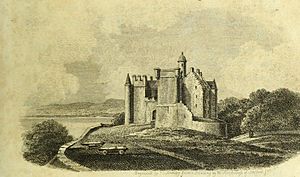Robert Sutherland, 6th Earl of Sutherland facts for kids
Quick facts for kids
Robert Sutherland, 6th Earl of Sutherland
|
|
|---|---|

Earl of Sutherland Coat of Arms
|
|
| Born | Unknown |
| Died | 1444 Dunrobin Castle, Sutherland, Scotland |
| Allegiance | Scotland |
| Relations | William de Moravia, 5th Earl of Sutherland (father) Margaret Stewart (wife) John Sutherland, 7th Earl of Sutherland (son) |
Robert Sutherland (died 1444) was an important leader in Scottish history. He was the 6th Earl of Sutherland and the head of the Clan Sutherland. This was a powerful Scottish clan from the Scottish Highlands.
Contents
Early Life of Robert Sutherland
Robert Sutherland, the 6th Earl of Sutherland, was the son of William de Moravia, 5th Earl of Sutherland. His mother was Joanna, daughter of Sir John Menteith. The family eventually took the name Sutherland from their earldom.
Some older history books had different ideas about who came before Robert. However, later research showed that Robert was indeed the son of the 5th Earl, William.
Robert Sutherland as Earl

Robert was first called the Earl of Sutherland in 1389. At that time, he was a witness to an important church decision. This decision was made against Alexander Stewart, Earl of Buchan, also known as the Wolf of Badenoch. It concerned his wife, Euphemia I, Countess of Ross.
Joining a Scottish Army
In 1388, the Earl of Sutherland joined a large meeting of Scottish nobles and their followers. This meeting took place at Southdean near Jedburgh. It led to the famous Battle of Otterburn. The Scots wanted to attack England because of problems between the English king and his nobles. They also wanted to get back at England for an invasion that happened three years earlier.
The Scottish army split into two groups. A smaller group, led by James Douglas, 2nd Earl of Douglas, marched towards Newcastle upon Tyne. They caused a lot of damage in areas like County Durham and almost reached Yorkshire. On their way back, they fought the Battle of Otterburn. Douglas was killed, but the Scots won the battle.
The larger Scottish force was led by Robert Stewart, Earl of Fife and Archibald Douglas, Lord of Galloway. This group entered England through the Scottish Marches and headed towards Carlisle. The Earl of Sutherland was part of this larger force.
Dunrobin Castle's First Record
On November 2, 1389, the Earl of Sutherland was a witness again. This time, it was for a decision telling the Earl of Buchan to live with his wife and treat her well. He had left her for another woman. This decision was made at a church in Inverness.
The next time we hear about Robert, Earl of Sutherland, is in 1401. He gave some land to his brother, Kenneth of Sutherland. This land included Drummoy, Torrish, and Backies. He also allowed the people of Backies to use the Glen for grazing animals.
The Earl kept the mill of Dunrobin for himself and his family. He also kept the rights to the running water and fish, except for a type of fish called "Pellokis." This official paper, called a charter, was signed at Dunrobin Castle. This is the first official record we have of the castle. Some historians thought the castle was built much earlier, but this 1401 record is the first real proof.
Clan Conflicts
Robert, the 6th Earl of Sutherland, was the chief of his clan for many years. During his time, his clan fought in a battle called the Battle of Drumnacoub. This battle was against the Clan Mackay.
Some old stories say that a supporter of the Earl of Sutherland, Angus Moray of Aberscross, offered his two daughters in marriage to two Mackay cousins. This was if they would take land from another Mackay leader, Angus Du Mackay. The Earl of Sutherland supposedly gave his full support to these cousins. In the battle, both cousins and Angus Moray were killed. Angus Du Mackay was also killed, but his sons kept his lands.
Robert Sutherland's Family
Robert, the 6th Earl of Sutherland, likely died in 1442. He was definitely gone by 1444, as his son John was called the Earl of Sutherland then. Robert married Margaret Stewart, who was the daughter of Alexander Stewart, the Wolf of Badenoch. They had three sons:
- John Sutherland, 7th Earl of Sutherland: He became the next Earl.
- Alexander Sutherland of Dunbeath: He was the second son. We know from an old will that he had two daughters who were legitimate (born within marriage). Their names were Marjory and Mariota (or Marion). He also had five sons and three daughters who were illegitimate (born outside of marriage).
- Robert Sutherland: Some stories say this Robert led forces that won a battle in 1455. He was supposedly sent by his older brother, John, the 7th Earl. Another story says he fought alongside the Clan Mackay in a battle in the 1480s. However, some historians doubt he was there. If he was, he would have been very old! One old book even says he was killed in that battle.
- Alexander Sutherland: Not much is known about this Alexander. He might have been the ancestor of another Alexander Sutherland who was killed in 1499.

